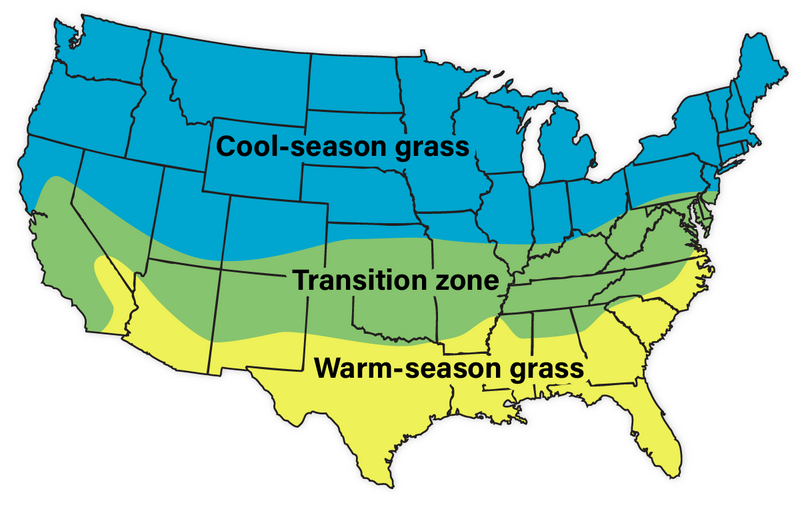
Want to know just how short (or tall) to keep your grass this growing season? We’ll discuss both cool-season and warm-season grasses and their ideal cutting heights. Keep reading, and you’ll be mowing like a pro in no time.
What type of grass do you have?
Let’s start by talking about grass type. Do you have cool-season grass or warm-season grass?

If you live in the northern area of the country, you probably have cool-season grass. Cool-season grasses such as perennial ryegrass, fescues, and Kentucky bluegrass are prevalent from Maine down to Pennsylvania and across the country to northern California.
If you live in the southern parts of the country, from southern South Carolina over to southern California, you probably have warm-season grass. Popular warm-season grasses include bermuda, St. Augustine, Zoysia, and centipede.
What about the middle of the country? That is called the Transition Zone, and both types of grass are used in this zone. The transition zone cuts a swath from Virginia to northern South Carolina across to the middle and lower parts of California.
Ideal cutting height by grass type
| Name | Type | Cutting Height for Home Lawns |
| Creeping red fescues | Cool Season | 3-3.5 inches |
| Kentucky bluegrass | Cool Season | 2.5-3.5 inches |
| Perennial ryegrass | Cool Season | 1.5-2.5 inches |
| Turf-Type Tall Fescue* | Cool Season | 2-3 inches |
| Centipedegrass* | Warm Season | 1-2 inches |
| Common bermudagrass* | Warm Season | 1-2 inches |
| Hybrid bermuda* | Warm Season | 1-1.5 inches |
| St. Augustine* | Warm Season | 2-3 inches |
| Zoysiagrass* | Warm Season | 1-2 inches |
- * Plan to add .5 inch to your mowing height during very warm weather.
How much to cut
Have you ever considered how much of the grass you’re cutting at one time? When you’re cutting your hair, there is no harm to your roots if you cut too much. The lawn is a little different.
There is a general rule of thumb in the landscaping industry called the one-third rule. This rule states that you should not mow more than one-third of the grass blade per mowing.
Mowing creates stress on the grass. If you remove too much of the leaf blade at once, the grass may stop growing the root system to put more energy toward the shoots and leaves.
A good example is that if your grass should be cut at 2 inches, wait until the grass is 3 inches to mow. You are only cutting off one-third of the grass, which should keep it nice and healthy and able to continue growing the roots and leaves at the same time.
It would be easier to say “cut once per week,” or to give some other set schedule. However, growing conditions vary throughout the mowing season, so during peak times of growth, you may plan to mow about twice per week and then gradually reduce the frequency during periods of slower growth.
Lawn care tips
- Sharpen your mower blades.
If you want your lawn to look “sharp,” use a sharp blade. Dull blades tear the grass, but a sharp blade gives it a cut that is clean and less likely to invite disease.
- Cut tall.
In general, tall grass is ideal, especially during warmer weather. Tall blades shade the soil and prevent some weeds, like crabgrass, from getting the sunlight they need to germinate. Also, a taller blade of grass encourages deeper root systems, which fortify against drought.
- Don’t bag the clippings.
With a few exceptions, you want to leave grass clippings on the lawn. Lawn clippings are like free fertilizer, and if you’re only cutting one-third of the blade at a time, the clippings will decompose quickly. Lawn clippings help to create a healthy lawn by providing a free source of nitrogen to your grass.
Pro Tip: Mulching lawn mowers do the best job at finely cutting up the blades of grass.
An ideal cut
One of the easiest ways to keep your grass healthy is simply to do regular lawn mowing at the right time. In this article, we’ve discussed the ideal height by grass type and how much you should mow at once. With a little bit of attention to these simple guidelines, you’re on your way to a healthier, happier lawn with every cut.
If you’re a homeowner who prefers to leave the grass chores to someone else, contact a lawn professional today.
Main Photo Credit: Ron Fung | Unsplash